“Rose House”
Pushed to name my favourite place in the centre of İstanbul, I’d probably plump for Gülhane Park, the enormous green space behind high walls that is one of the city’s great delights, especially in summer but at all times of year really. Once part of the gardens of the Topkapı Palace, the park is now entirely separate from it although you can still reach it by going through the main gate into the palace grounds and then turning left downhill past the entrance to the İstanbul Archaeology Museum. This is the nicest approach (unless you mind the security barriers) although a stroll downhill past the restored Ottoman houses of Söğükçeşme Sokağı is almost as enjoyable.
In winter the huge plane trees that line the main path stand like ghosts alongside it, their branches filling up after Christmas with the nests of the local herons. In spring the flowerbeds are full of tulips as the city celebrates its annual Tulip Festival. Then in June the roses come into bloom in the rose garden in front of the Museum of the History of Islamic Science and Technology. Finally in autumn the leaves start to change colour, bringing an entirely new look to the park.
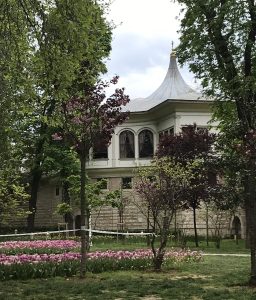 Inside the park
Inside the park
If you enter the park from the gate opposite the Zeynep Sultan Cami on the tramline you will see, immediately to the left, the Alay Köşkü (Parade Pavilion), a gazebo that sits on the park walls looking out on one side to the tram and on the other to the park. This was where the sultan would once have watched processions taking place in the street outside.
The original Parade Pavilion was probably built in the 15th century during the reign of Sultan Mehmed II although the current version is the one created in 1819 for Sultan Mahmud II. A long stone ramp leading to the main entrance is a reminder that the sultan would have arrived by horse to review the procession.
The Köşk is now a library and museum of Turkish literature, a place to come to find out about the many Turkish authors who are yet to find much of a following outside the country.
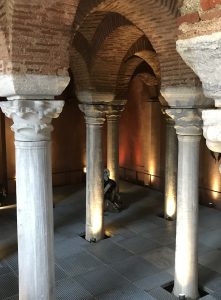
If you follow the wall of the park round on the left you will soon come to the Museum of the History of Islamic Science and Technology (open daily, admission TL210) whose name hardly suggests the state-of-the-art exhibition inside. While it’s true that most of the items on display are models of inventions sourced to the Islamic world rather than original items, they are attractively laid out and the information is clearly presented. Come here in particular to learn about the chequered history of İstanbul’s own Observatory.
In front of the museum a special garden is dedicated to the flowers to be found in the Turkish Republic of Northern Cyprus.
If you then walk back to the main path you will see, set back on the right side, the small St George cistern. It was only rediscovered in 1913 and for many years served as an aquarium for the zoo in the park. Restored in the 2010s, it now hosts temporary art exhibitions.
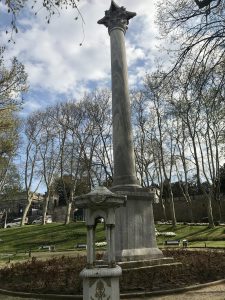 On the far side of the park and uphill you will find the Goths Column, a granite column topped with a Corinthian capital which may once have supported a statue of Byzas, the Greek credited with the foundation of Byzantium, later Constantinople. Although the base of the column bears an inscription, it’s unclear whether this column dates back to the 3rd or 4th century when it seems to have been erected to celebrate a Byzantine victory over invading Goths.
On the far side of the park and uphill you will find the Goths Column, a granite column topped with a Corinthian capital which may once have supported a statue of Byzas, the Greek credited with the foundation of Byzantium, later Constantinople. Although the base of the column bears an inscription, it’s unclear whether this column dates back to the 3rd or 4th century when it seems to have been erected to celebrate a Byzantine victory over invading Goths.
If you leave the park on its water-facing side you will find yourself at Sarayburnu (Seraglio Point), a popular spot for gazing across the Bosphorus towards Kadıköy. Here stands what was the first ever statue of Atatürk designed by the Austrian Heinrinck Krippel in 1926. In 2024 excavations were going on on the headland.
Birds of Gülhane The heronry in the park dates back to early Ottoman times when the sultans often wore heron plumes in their turbans. Much more recent arrivals are the rose-necked parakeets who can constantly be heard screeching overhead. There is also a small group of mynah birds that live in the park near the Topkapı walls.
Around the park
If you walk from Seraglio Point towards Sirkeci you will pass a sweet little stone building called the Sepetçiler Kasrı (Basketmakers Pavilion) built in 1643 for Sultan İbrahim the Mad. Used as a boathouse, it was also the launchpad whenever the sultans wanted to take a boat trip. It is now the HQ of Yeşilay, the Turkish temperance organisation.
If, however, you exit the park on the inland side you will be able to take a look at the Alay Köşkü from the outside. Facing it across the tramlines stands a gateway with a huge, decorative overhang. Officially known as Bab-ı Ali, this was the Sublime Porte, the monumental entrance to what was once the enclave of the grand vizier, roughly the Ottoman equivalent of the British prime minister. It was Sokollu Mehmed Paşa who first based himself here in 1564, after which more and more governmental business was conducted here rather than in the old Divan (Council Chamber) inside the Topkapı Sarayı. Eventually the gate came to symbolise the Ottoman government so strongly that foreign ambassadors were said to be accredited to the Sublime Porte.
If you then walk back up the tramlines towards Sultanahmet you will see on the far side of the tramlines what was until recently a children’s court housed in a building erected in 1875 to serve as a military college. It is now a university building.Past it stands the Zeynep Sultan Cami designed by Mehmed Tahir Ağa in 1760 for the daughter of Sultan Ahmed III. Beside it is what was once a contemporary primary school and now houses the Turkish Monuments Association. Both buildings illustrate the way in which aspects of Byzantine architecture – the striped brickwork, the dome of the mosque – continued into quite late in the Ottoman era.
In front of the mosque stands a late 18th-century sebil, one of the decorative fountains from which drinks were dispensed to passers-by. Although it looks as if it’s been standing here forever, it was actually moved here from beside Sultan Abdülhamid’s tomb in Eminönü when the roads in that area were widened in the 1950s.
Across the road from the Turkish Monuments Association is a building which it’s quite easy to overlook unless you are looking across at it, yet which is a work of the great Ottoman architect, Sinan, whose bust stands in its courtyard. This is the many-chimneyed Caferağa Medresesi, built in the 1550s for Cafer and Gazenfer Ağa, brothers who both held the office of Chief White Eunuch in Topkapı Sarayı. To get into the medrese you have to walk right round it to the far side. Once there you’ll find yourself in a peaceful haven where you can eat a light meal or browse the craft workshops.
If you don’t want to walk back to Sultanahmet along the tramlines you could instead take the steep cobbled street that runs up from beside the park exit to the back to Ayasofya. Söğükçeşme Sokağı was once a dejected street of crumbling wooden buildings until it was taken under his wing by Çelik Gülersoy (1930-2003), the man who began restoring the old Ottoman buildings long before it was fashionable to do so. Today the pretty pastel-coloured houses form the Ayasofya Mansions (Ayasofya Konakları), one of the city’s most atmospheric places to stay, with the grounds of Topkapı immediately behind them and Ayasofya immediately in front. Turkey’s sixth president, Fahri Korutürk, was born in this street in 1903.
Here, too, is the atmospheric Sarnıç Restaurant housed in one of the many Byzantine cisterns dotted about the city.
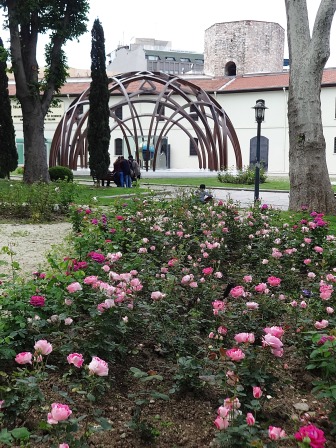 Sleeping
Sleeping
Hardly a day goes by without a new hotel opening in the part of town between the Gülhane and Sirkeci tram stops. Except at the very busiest times you should be able to find somewhere to sleep here although little of the accommodation is particularly cheap.
Orient Epress. Tel: 0212-520 7161
Transport info
Although the park is within easy walking distance of Sultanahmet there is a tram stop at Gülhane which is very close to one of its entrances.
Nearby areas
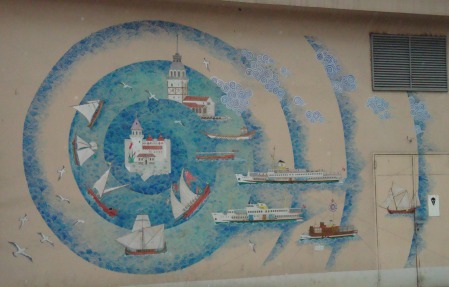 Painting by the late Nusret Çolpan (1952-2008)
Painting by the late Nusret Çolpan (1952-2008)

